
An imprint of Penguin Random House LLC 375 Hudson Street New York, New York 10014 Copyright 1983, 1985, 1987, 1988, 19902017 by Penguin Random House LLC Penguin supports copyright. Copyright fuels creativity, encourages diverse voices, promotes free speech, and creates a vibrant culture. Thank you for buying an authorized edition of this book and for complying with copyright laws by not reproducing, scanning, or distributing any part of it in any form without permission. You are supporting writers and allowing Penguin to continue to publish books for every reader. TarcherPerigee with tp colophon is a registered trademark of Penguin Random House LLC. ISBN: 978-0-525-50376-7 Neither the publisher nor the author is engaged in rendering professional advice or services to the individual reader.
The ideas, procedures, and suggestions contained in this book are not intended as a substitute for consulting with your physician. All matters regarding your health require medical supervision. Neither the author nor the publisher shall be liable or responsible for any loss or damage allegedly arising from any information or suggestion in this book. Cover images: ajt / Shutterstock Version_1 A BOUT THE A UTHOR H. Winter Griffith, M.D., authored 25 medical books, including the Complete Guide to Symptoms, Illness & Surgery and Complete Guide to Sports Injuries, each published by The Body Press/Perigee Books. Dr.
Griffith received his medical degree from Emory University in Atlanta, Georgia. After 20 years in private practice, he established and was the first director of a basic medical science program at Florida State University. He then became an associate professor of Family and Community Medicine at the University of Arizona College of Medicine. Until his death in 1993, Dr. Griffith lived in Tucson, Arizona. EditorStephen Moore, M.D. Family physician, Tucson, Arizona Technical ConsultantsKevin Boesen, Pharm.D. Clinical Assistant Professor, College of Pharmacy, University of Arizona Cindy Boesen, Pharm.D. Clinical Instructor, College of Pharmacy, University of Arizona Technical EditorJo A.
Griffith
Drugs and You
What is in This Book The purpose of this book is to give you information about the most widely used drugs (prescription and nonprescription). The information is derived from many authoritative sources and represents the consensus of many experts. Every effort has been made to ensure accuracy and completeness. However, because drug information is constantly changing, you should always talk to your doctor or pharmacist if you have any questions or concerns. The information applies to generic drugs in both the United States and Canada. Generic names do not vary in these countries, but brand names do.
Each year, new drug charts are added and existing charts are updated when appropriate. For the most part, drugs that are injected by a medical professional, used mainly in a hospital (or medical clinic) or have rare usage are not included. A drug cannot cure. It aids the bodys natural defenses to promote recovery. Likewise, a manufacturer or doctor cannot guarantee a drug will help every person. The complexity of the human body, individual responses in different people and in the same person under different circumstances, past and present health, age and gender impact how well a drug works.
All effective drugs produce desirable changes in the body, but can also cause undesirable adverse reactions or side effects. Before you decide whether to take a drug, you or your doctor must decide, Will the benefits outweigh the risks? In the United States, it is the responsibility of the Food and Drug Administration (FDA) to ensure that drugs are safe and effective. For more information, you may contact the FDA at 1-888-INFO-FDA or visit the website: www.fda.gov. Your Role Learn the generic names and brand names of all your medicines. For example, acetaminophen is the generic name for the brand Tylenol. Write them down to help you remember.
If a drug is a combination, learn the names of its generic ingredients. Filling a Prescription Once a prescription is written you may purchase the medication from various sources. Pharmacies are usually located in a drug or grocery store. You may need to consider your options: Does your health insurance limit where prescriptions can be filled? Is the location convenient? Does the pharmacy maintain patient records and are the employees helpful and willing to answer drug related questions? Insurance companies or an HMO (Health Maintenance Organization) may specify certain pharmacies. Some insurance companies have chosen a mail-order pharmacy. Normally a prescription is sent to the mail-order pharmacy or phoned in by the physician.
Mail order is best used for maintenance (long-term medications). Short-term medications such as antibiotics should be purchased at a local pharmacy. Once a pharmacy has been chosen it is best to stay with that one so an accurate drug history can be maintained. The pharmacist can more easily check for drug interactions that may be potentially harmful to the patient or decrease the efficacy of one or more of the medications. You can phone the pharmacy for a refill. Taking a Drug Read the instructions provided with the drug and follow all directions for taking or using it. Taking a Drug Read the instructions provided with the drug and follow all directions for taking or using it.
Never take medicine in the dark! Recheck the label before each use. You could be taking the wrong drug! Tell your doctor about any unexpected new symptoms you have while taking or using a drug. You may need to change drugs or have a dose adjustment. Storage Keep all medicines out of childrens reach and in childproof containers. Store drugs in a cool, dry place, such as a kitchen cabinet or bedroom. Avoid medicine cabinets in bathrooms.
They get too moist and warm at times. Keep medicine in its original container, tightly closed. Dont remove the label! If directions call for refrigeration, keep the medicine cool, but dont freeze it. Discarding Dont save leftover medicine to use later. Discard it on or before the expiration date shown on the container. See . Alertness Many of the medicines used to treat disorders may alter your alertness. Alertness Many of the medicines used to treat disorders may alter your alertness.
If you drive, work around machinery, or must avoid sedation, discuss the problem with your doctor; usually there are ways (e.g., the time of day you take the medicine) to manage the problem. Alcohol & Medications Alcohol and drugs of abuse defeat the purpose of many medications. For example, alcohol causes depression; if you drink and are depressed, antidepressants will not relieve the depression. If you have a problem with drinking or drugs, discuss it with your doctor. There are ways to help. Learn About Drugs Study the information in this books charts regarding your medications.
Read each chart completely. Because of space limitations, most information that fits more than one category appears only once. Any time you are prescribed a new medication, read the information on the chart for that drug, then take the time to review the charts on other medications you already take. Read any instruction sheets or printed warnings provided by your doctor or pharmacist.

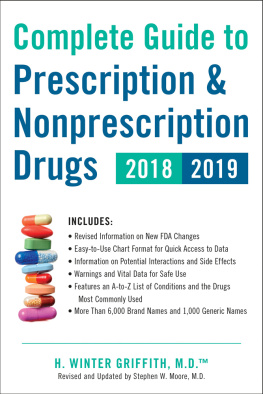

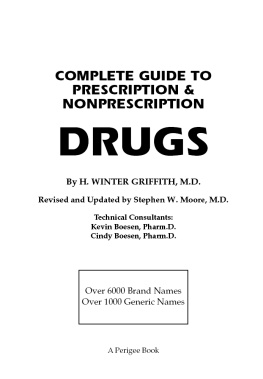
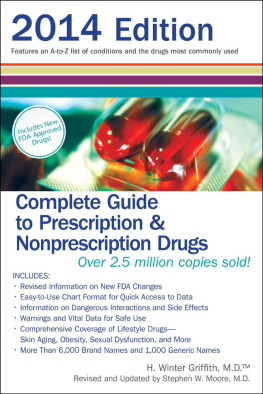
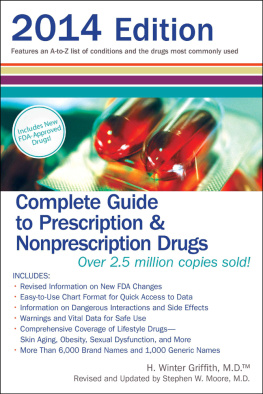

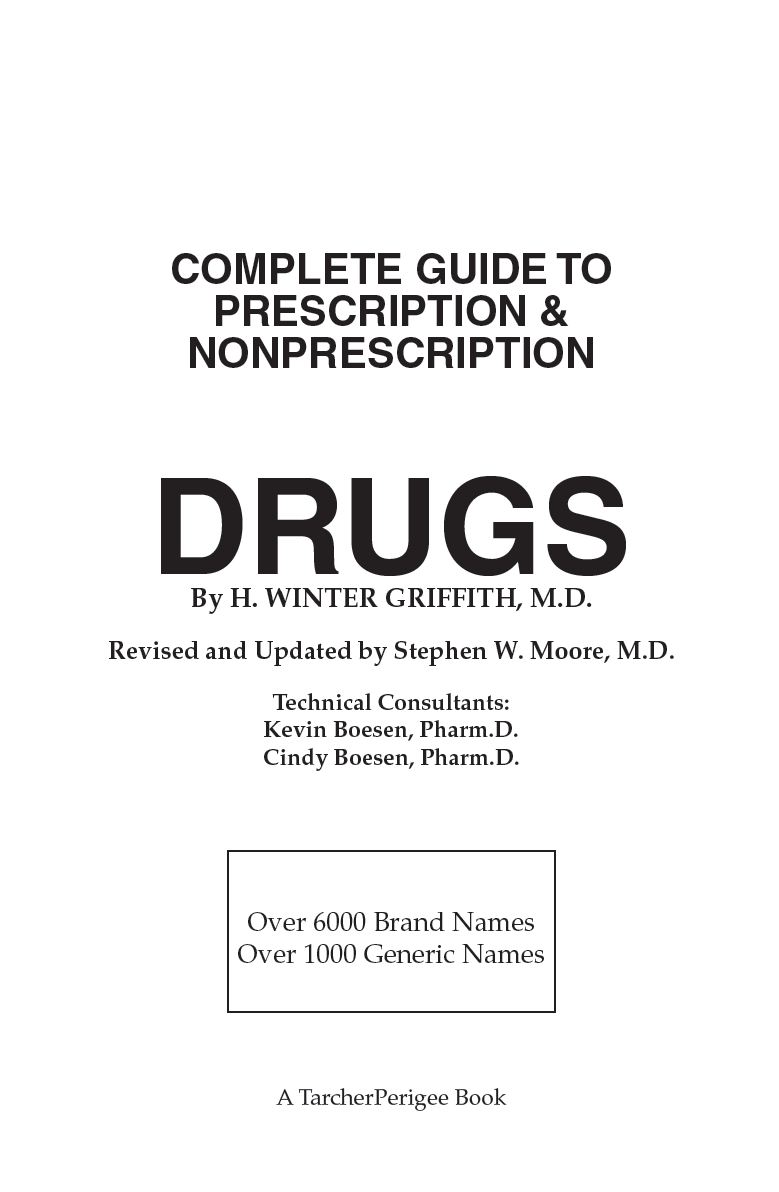
 An imprint of Penguin Random House LLC 375 Hudson Street New York, New York 10014 Copyright 1983, 1985, 1987, 1988, 19902017 by Penguin Random House LLC Penguin supports copyright. Copyright fuels creativity, encourages diverse voices, promotes free speech, and creates a vibrant culture. Thank you for buying an authorized edition of this book and for complying with copyright laws by not reproducing, scanning, or distributing any part of it in any form without permission. You are supporting writers and allowing Penguin to continue to publish books for every reader. TarcherPerigee with tp colophon is a registered trademark of Penguin Random House LLC. ISBN: 978-0-525-50376-7 Neither the publisher nor the author is engaged in rendering professional advice or services to the individual reader.
An imprint of Penguin Random House LLC 375 Hudson Street New York, New York 10014 Copyright 1983, 1985, 1987, 1988, 19902017 by Penguin Random House LLC Penguin supports copyright. Copyright fuels creativity, encourages diverse voices, promotes free speech, and creates a vibrant culture. Thank you for buying an authorized edition of this book and for complying with copyright laws by not reproducing, scanning, or distributing any part of it in any form without permission. You are supporting writers and allowing Penguin to continue to publish books for every reader. TarcherPerigee with tp colophon is a registered trademark of Penguin Random House LLC. ISBN: 978-0-525-50376-7 Neither the publisher nor the author is engaged in rendering professional advice or services to the individual reader.